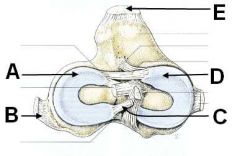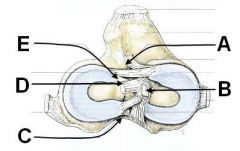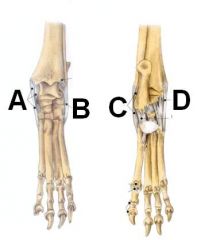![]()
![]()
![]()
Use LEFT and RIGHT arrow keys to navigate between flashcards;
Use UP and DOWN arrow keys to flip the card;
H to show hint;
A reads text to speech;
15 Cards in this Set
- Front
- Back
|
What are the joints of the stifle? What type of joint is this?
|
Femorotibial
Femoropatellar Proximal tibiofibular Condylar synovial joint |
|
|
T or F:
The joint capsule of the hip is the largest joint capsule in the body. |
False! It's the stifle!
|
|
|
What are the synovial sacs of the stifle. Which ones intercommunicate?
|
Medial and lateral femorotibial and femoropatellar joint sacs
All intercommunicate |
|

ID THIS!!
|

A - Lateral meniscus
B - Lateral collateral ligament C - Meniscofemoral ligament D - Medial meniscus E - Patellar ligament |
|

|

A - Cranial meniscotibial ligament
B - Caudal cruciate ligament C - Caudial meniscotibial ligament D - Cranial cruciate ligament E - Cranial meniscotibial ligament |
|
|
What separates the synovial and fibrous layers of the stifle joint capsule?
|
Infrapatelar fat pad
|
|
|
What are the four ligaments attaching the tibia to the femur?
|
Medial and lateral collateral femorotibial ligaments
Cranial and caudal cruciate ligaments |
|
|
Which meniscus is thicker?
|
Lateral is thicker
|
|
|
Which structures prevent patellar dislocation?
|
parapatellar fibrocartilages
|
|
|
What ligament prevents cranial sliding of the proximal tibia?
|
Cranial cruciate ligament
|
|
|
Which collateral ligaments are tight when the stifle is extended? Which are loose when the stifle is flexed?
|
Both are tight upon extension
Lateral loosens on flexion |
|
|
Which ligaments are tight when the stifle is extended?
|
Cranial and caudal cruciate ligaments
Both medial and lateral collateral ligaments |
|
|
T or F:
The cruciate ligaments are the only thing preventing external rotation during flexion and extension. |
False! This describes the collateral ligaments
|
|
|
What test determines if there is a cranial cruciate ligament rupture?
|
Cranial drawer test
|
|

|

A - Medial collateral lig.
B - Lateral collateral lig. C - Lateral collateral lig. D - Medial collateral lig. |

